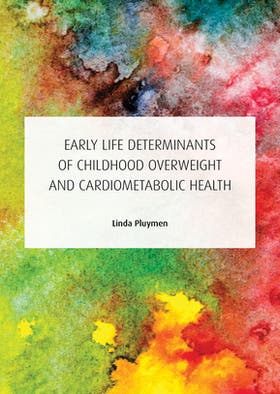Linda Pluymen
Early life determinants of childhood overweight and cardiometabolic health

- Datum
- (Co) promotoren
- 06-11-2018
- prof.dr.ir. H.A. Smit, dr.ir. L. van Rossem
Samenvatting
The hypothesis on the influence of prenatal conditions on cardiovascular disease (CVD) risk in adulthood has become known as the “Developmental Origins of Health and Disease (DOHaD)” and has been supported by results from many epidemiological studies. There is growing recognition that the CVD process already starts in childhood, but less is known about the influence of early life conditions on CVD risk in childhood. The aim of this thesis was to investigate whether exposures during pregnancy and up to one year of age, are determinants of overweight and cardiometabolic health in childhood. To answer my research question, I performed a systematic review of the literature and I used the data from two Dutch birth cohorts. The Prevention and Incidence of Asthma and Mite Allergy study is a population based ongoing cohort that has followed Dutch children from before birth in 1996-1997 until early adulthood. The baseline population consisted of 3,963 children. We used the data for three studies in this thesis. Data on the exposures, i.e. CS delivery, breastfeeding and early introduction of complementary foods, were retrieved from parental questionnaires at the child’s age of 3 months and 1 year. Data on overweight and cardiometabolic markers were retrieved from clinical examinations at 4, 8, 12 and 16 years or from parental questionnaires at 1 until 8 years, 11, 14 and 17 years. The Wheezing Illnesses STudy LEidsche Rijn (WHISTLER) is an ongoing birth cohort in Leidsche Rijn, a residential area near the city of Utrecht, The Netherlands.Between 2001 and 2014, almost 3,000 newborns were enrolled in the study. We used the data for one study in this thesis. Data on infant formula with LCPUFAs were retrieved from 12 monthly parental questionnaires in the child’s first year of life. Data on blood pressure and vascular wall characteristics were retrieved from the clinical examination at 5 years. Based on the results in this thesis and on results of previous studies, I conclude that the risk of childhood overweight is, at least partly, increased by cesarean section delivery and decreased by breastfeeding and introduction of complementary foods after 4 months of age. Although our systematic review showed a higher blood pressure in children who were exposed in utero to a mother with pregnancy induced hypertension, and a lower blood pressure in breastfed children, I conclude that the observed association for both exposures is unlikely to be causal. With respect to the other cardiometabolic markers, the studies in this thesis showed no evidence for a relation with the early life risk factors of interest. The overall conclusion is that exposures during pregnancy and up to one year of age are determinants of childhood overweight but not of childhood cardiometabolic health. For future research, I hypothesize that early life determinants may have an effect on cardiometabolic health through their effect on overweight, and if this is the case, then this may come to expression later in life.
